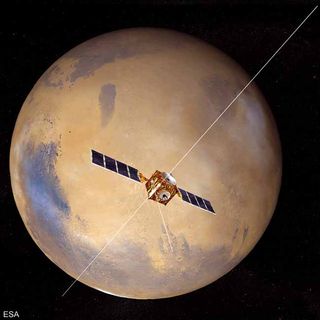Risky Mars Moon Flyby Tops Europe's 2013 Space Goals

A risky flyby of the Mars moon Phobos, a dip into the atmosphere of Venus and the creation of a comprehensive water map of the Red Planet are three goals the European Space Agency has laid out for 2013, officials announced last week.
In June, ESA will publish a map of the entire surface of Mars detailing the location of water-containing hydrate compounds, based on observations by the agency's Mars Express spacecraft.
"We will be revealing a mineralogical map of Mars — the whole planet — based on Mars Express data," ESA director-general Jean-Jacques Dordain said in his annual breakfast briefing in Paris on Jan. 24. "What we’re most interested in is the hydrates, as that will give us valuable information about the history of water on the surface of Mars."
This year, Mars Express will also make an extremely close flyby of Phobos, one of the Red Planet's two tiny moons, Dordain added. [Europe's Mars Express Mission in Photos]
"We’ll run that mission with Mars Express; there is a risk," he said. "It is not just a flyby; it is almost within touching distance."
The spacecraft's orbit around Mars will be altered so it flies past Phobos at a distance of just 36 miles (58 kilometers) — far closer than Mars Express' 2011 Phobos encounter, which brought it to within 62 miles (100 km) of the moon.
"This [36-mile flyby] will give us unique data on Phobos. As you probably know, it is an object that is attracting huge attention, particularly from Russia," Dordain said, referring to Russia’s Phobos-Grunt mission, which launched in November 2011 in an attempt to return a sample from the moon. Phobos-Grunt failed to leave Earth orbit and fell into the Pacific Ocean in January 2012.
Sign up for the Live Science daily newsletter now
Get the world’s most fascinating discoveries delivered straight to your inbox.
Russian scientists’ interest in Phobos goes back to 1959, when the Ukrainian-born Soviet astrophysicist Iosif Samuilovich Shklovsky wrote a paper suggesting the orbit of the moon implies it is hollow and could therefore be an artificial spaceship.
ESA is interested in Phobos exploration to learn more about eventual sample-return missions, and the hydrates map should help pave the way for such an effort on Mars, Dordain said.
"This will mean we can start looking for landing sites for the Exomars mission," Dordain said of the Mar Express hydrates map. Exomars is not a sample-return mission, but it will look for evidence of Red Planet life.
An Exomars orbiter and lander will be launched in 2016, and in 2018 a rover will be sent to the Red Planet. While ExoMars was originally an ESA-only mission, NASA became a major partner but then reduced its role last year to just onboard electronics due to budget problems. Now Russia’s Federal Space Agency, known as Roscosmos, is ESA's major partner.
Dordain also revealed that ESA plans to learn more about a maneuver called aerobraking by sending its Venus Express orbiter into a lower orbit around Earth's hellishly hot "sister planet."
Aerobraking uses a planet's atmosphere, rather than rocket engines, to slow a probe down as it settles into orbit. The move can save fuel, potentially making spacecraft lighter and thus cheaper to launch.

In orbit since April 2006, Venus Express’ mission is to study the atmosphere and surface of the planet. Its observations have hinted that Venus may still have active volcanoes.
Dordain’s briefing follows the agency’s November 2012 meeting of its member states’ space ministers. That meeting approved an increased budget for ESA, granting 4.2 billion euros ($5.7 billion at current exchange rates) for 2013.
That meeting also approved the provision of a service module for NASA’s Orion spacecraft. Dordain revealed that the module that will fly in 2017 will cost 450 million euros ($606 million).
He has high hopes for the coming year.
"We’re expecting tremendous results in 2013," Dordain said.
This story was provided by SPACE.com, a sister site to Live Science. Follow SPACE.com on Twitter @Spacedotcom. We're also on Facebook & Google+.












